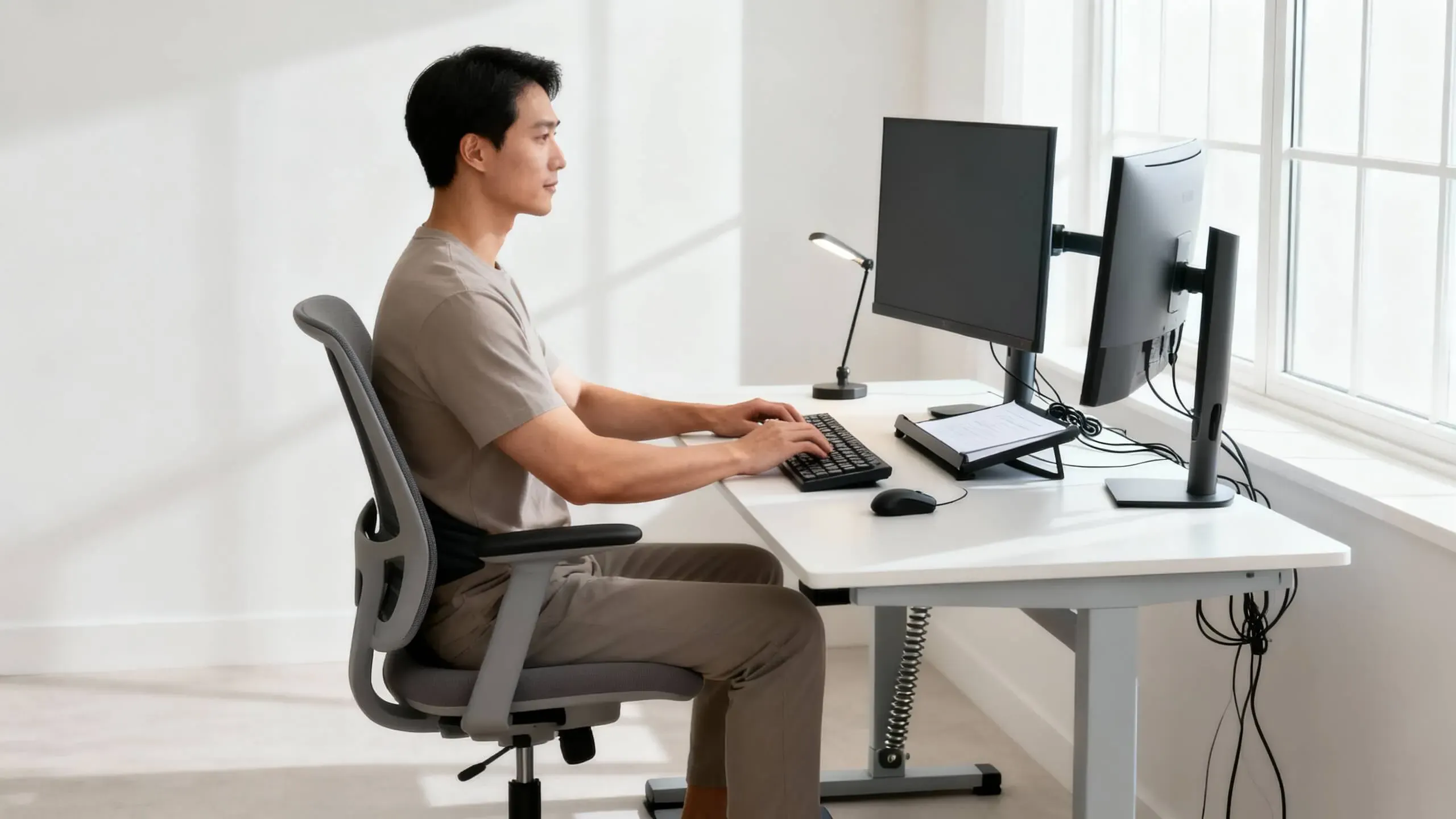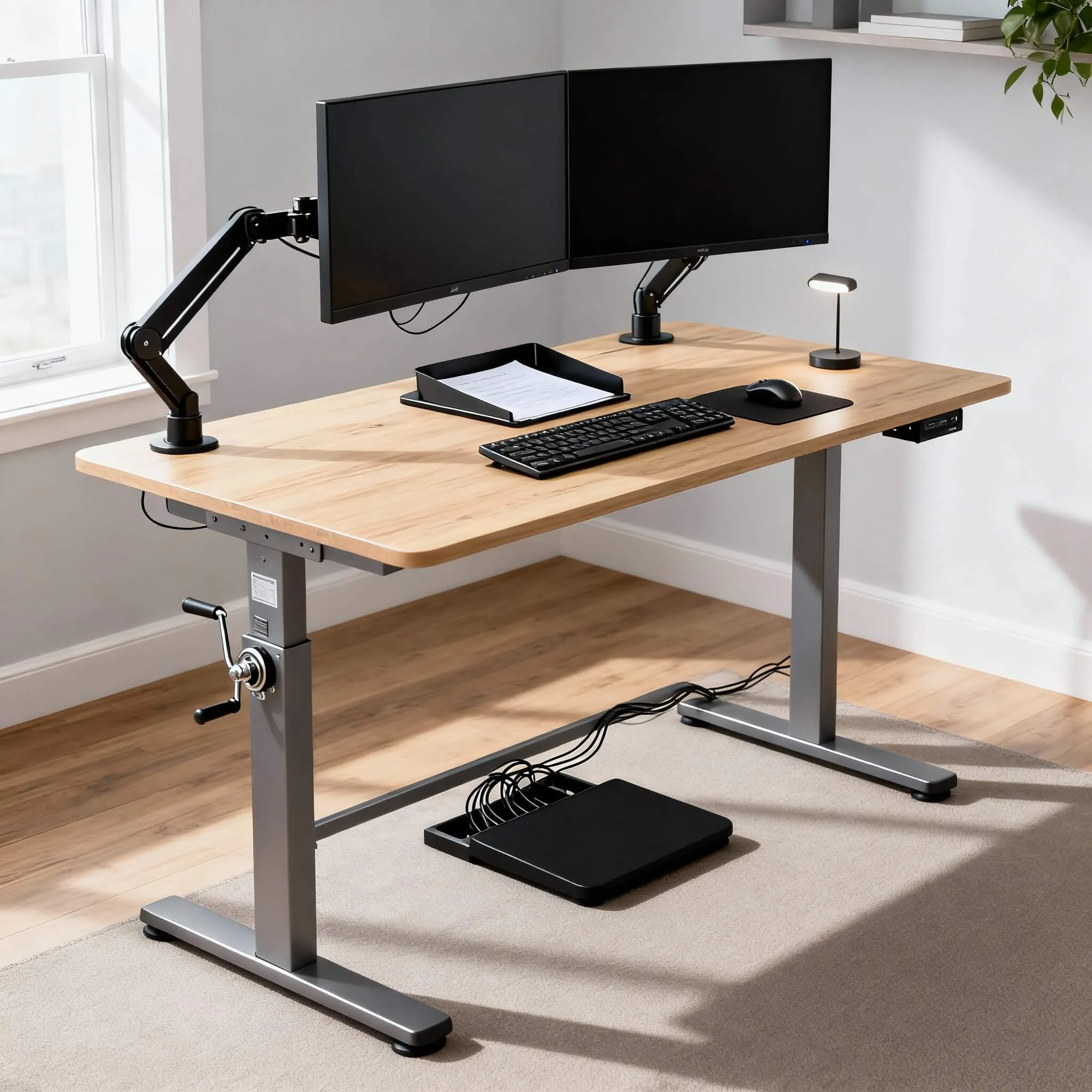Optimize the Workstation Layout
Getting your workstation layout right is one of the simplest ways to reduce strain, improve focus, and stay comfortable through long days. The goal is a setup that fits you—not the other way around. Use the guidelines below to fine-tune your space. If you use a manual height adjustable table, you’ll have even more flexibility to fine tune your setup.

Let’s go through the key points to follow for an ergonomically designed workstation.
1. Monitor distance: roughly an arm’s length
- Position the main screen about an arm’s length away (roughly 50–70 cm for most people).
- Your eyes should be looking at the top third of the screen when you look straight ahead.
- If you find yourself leaning forward, the screen is likely too far, too small, or too low. Move it closer or raise it.
- Reduce glare with a slight downward tilt and by placing the monitor perpendicular to windows.
2. Dual monitors: main monitor centered; secondary angled
- Center your primary monitor directly in front of you to avoid twisting your neck.
- Angle the secondary monitor toward you at about 15–30 degrees so both screens form a gentle curve.
- If you use both equally, place them side-by-side with the seam centered and angle both slightly.
- Keep both monitors at the same height; eyes should hit the top third of each display.
3. Keyboard: keep close; negative tilt can help neutral wrists
- Bring the keyboard close enough that your elbows stay near your body and your shoulders can relax.
- Keep forearms parallel to the floor with wrists straight. A slight negative tilt (front edge higher than the back) helps maintain neutral wrists.
- Low-profile keyboards often reduce extension at the wrist. Consider a split keyboard if you notice shoulder tension or ulnar deviation.
4. Mouse: same height as keyboard; reduce reach
- Place the mouse at the same height and on the same plane as the keyboard to prevent shoulder hike.
- Keep it close—ideally, your upper arm stays vertical and your elbow bent about 90 degrees.
- If you do heavy mouse work, consider a larger surface to reduce picking up and repositioning, or try an ergonomic mouse or a trackball to minimize reach.
- Match mouse sensitivity to reduce excessive hand movement.
5. Desk height: matches elbow height
- Adjust desk height so your elbows are at about 90 degrees with shoulders relaxed and wrists neutral while typing.
- If your desk isn’t adjustable, raise or lower the chair to match elbow height and then use a footrest if needed.
- A height adjustable table can make it easy to fine-tune height for both sitting and standing without overcomplicating the setup.
6. Footrests: when feet don’t comfortably reach the floor
- If raising your chair for desk height leaves your feet dangling or barely touching, use a footrest to support the entire foot.
- Aim for knees at or slightly below hip height to keep the pelvis neutral.
- A simple wedge or adjustable footrest works; even a sturdy box can help in a pinch.
7. Extra tips to tie it all together
- Cable management: tidy cables so you can freely move the keyboard and mouse closer without snags.
- Document placement: if you reference papers often, use a document holder between keyboard and monitor to reduce neck rotation.
- Lighting: position a task light opposite your dominant hand to reduce shadows; avoid placing bright lights behind the monitor.
8. Quick setup sequence
- Chair first: set seat height so knees are at or slightly below hip level; adjust back support.
- Desk second: match desk height to your relaxed elbow height.
- Keyboard and mouse: bring them close and level; check wrist neutrality.
- Monitors: set distance (arm’s length), height (top third at eye level), and angle (especially for dual screens).
- Footrest: add if feet don’t rest flat with the above settings.

Conclusion: A well-laid-out workstation isn’t about chasing a single “perfect” posture. It’s about minimizing strain and making small adjustments that keep you comfortable and focused. Start with elbow-height desk alignment, bring your keyboard and mouse closer, position monitors at arm’s length with eyes to the top third, and support your feet if needed. Then make micro-adjustments over a few days and notice how your neck, shoulders, and wrists feel. With a few thoughtful tweaks—and the flexibility of tools like a manual height adjustable table—you can create a setup that supports your body and your work, day after day.
